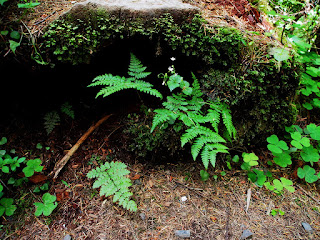 |
| Big Leaf Maple, 11/07/2014 |
As November arrives, I finally have to face the inevitable truth. Summer is really gone and Fall is here. Especially when we do that annual clock dance and "daylight saving" ends, leaving us dazed and confused. The reality also hits home when the trusty hiking shorts stay in the drawer day after day. For us nature lovers all is not lost however. Before we resort to taking pictures of our pets, we can still head outside - no wildflowers to bag, but plenty of other things to find.
If you've been out and about on a trail in the last couple of weeks then you've noticed the foliage show all over the state. Here in the lowlands of western Oregon we peaked about a week ago, which got me thinking about how this all happens. After living here in the area for more than 30 years, it seems that the leaf color changes happen at the same time regardless of climate. And it also seems that most of our native broadleaf trees around here produce mostly gold and yellow colors.
 |
| Black Cottonwood, 11/22/2013 |
So I spent a couple of days wading through some of the Internet articles about fall foliage and leaf colors. Don't worry though, I'm not going to spell out the entire process here. You can follow the links below for the full-meal-deal, which is actually pretty interesting if you are so inclined.
Suffice to say, even though trees don't have a brain, they are well equipped to recognize seasonal changes. The leafy trees can detect the amount of daylight and use that as a calendar of sorts to set in motion a chain of events to drop their leaves and prepare for winter. When the length-of-day threshold is reached for a given tree, it gradually stops making any new chlorophyll. The lack of chlorophyll allows the leaf's color pigments to show. That is why this preparation happens at the same time every year, regardless of weather conditions. That answered my first question about when, but how about the colors?

Well, the very short version of this answer is that most of our native broadleaf deciduous trees here in western Oregon seem to have more xanthophylls (yellow) pigments in their leaves. Trees such as Big Leaf Maple, Black Cottonwood, Willow, Oregon Ash, White Oak, and Red Alder all have the dominating yellow pigments that make them appear gold and yellow as the chlorophyll fades away. We have a few native trees that have more orange (carotenoids) and purple (anthocyanins) pigments, such as dogwood and vine maple.

And finally, the year-to-year variations in the appearance or "quality" of the foliage show are due to temperature, moisture content in soil, and amount of sunlight. Eventually the leaves no longer receive any nutrients from the stems and they drop off and head straight to your rain gutters.
 |
| Oregon Ash, 10/16/2015 |
I couldn't really find any articles as to why so many of our native broadleaf trees have the xanthophylls pigment. My guess is that it is probably an evolutionary adaptation to attract or repel critters, or perhaps just a factor of what's in the soil and air.

Another interesting topic for outdoorsy retired people like me to ponder is "What is it about Fall leaves that bring us delight?" For many there is an almost spiritual value to a good day of leaf admiration. This
recent article from Psychology Today offers a few insights, including stress reduction, visual stimulation, and childhood memories.
Of course the visual arts, poets, and musicians have ridden on the coattails of Fall foliage seemingly forever. One enduring contribution is "Autumn Leaves" as performed by nearly every singer and jazz musician in the past 60 years. It was originally written in France, and later adapted by Johnny Mercer and performed by Jo Stafford. Take a look on the
Wiki page for this historic song!
So, to wrap up this post, as those prospectors used to say, "get out there and enjoy the gold before it's gone!"
Links:
Overview of Fall Color
USDA Blurb
Wikipedia on Fall Leaf Colors
Psychology Today on Leaf Color





















